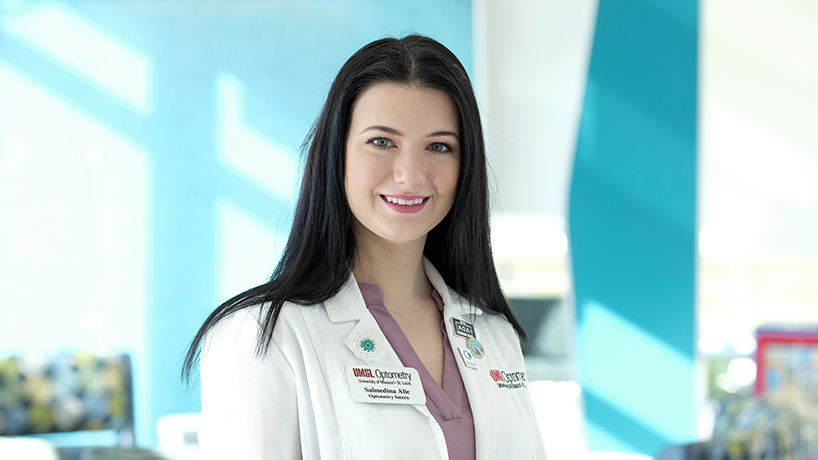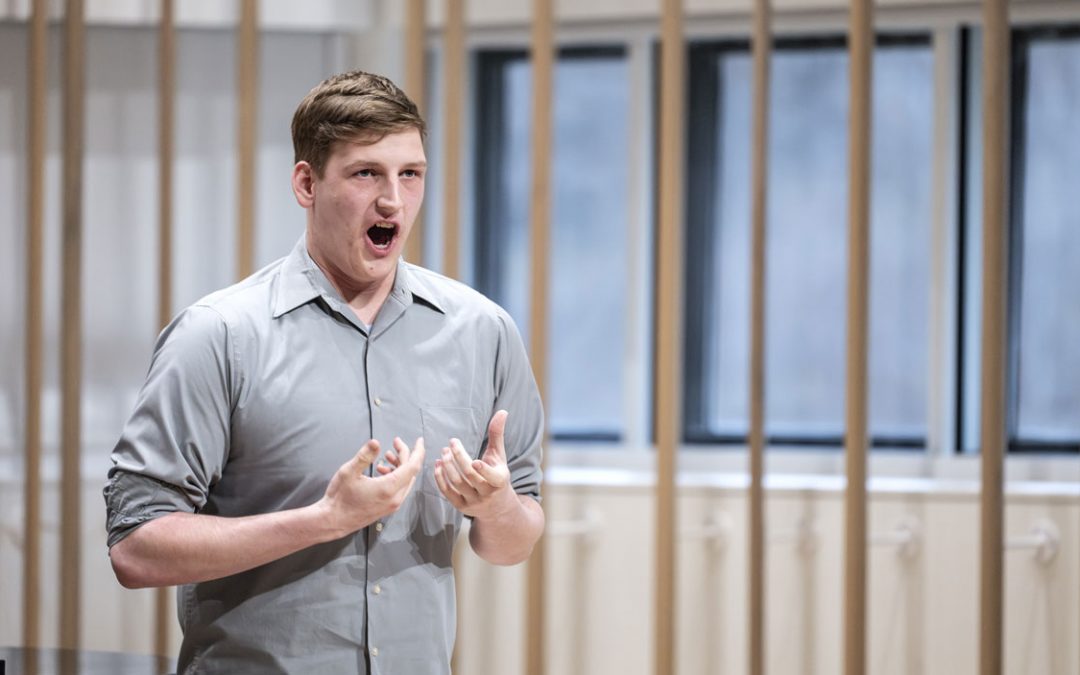
Salmedina Alic fell in love with optometry after talking to a group of students at UMSL Day in 2015. Now she’s three years into a OD degree at the University of Missouri–St. Louis. (Photo by August Jennewein)
Salmedina Alic already had an acceptance letter in her inbox by the time she got home after her interview with the College of Optometry at the University of Missouri–St. Louis.
That’s a good thing because, for her, it was UMSL or nothing.
“If I didn’t get in, I was going to wait until next year and apply again,” Alic said. “I was very happy. I couldn’t believe it. I was still judging myself for certain things. I was like, ‘I should have done this and that.’ My friend was there, and she’s like, ‘You got in. It doesn’t matter.’”
Though she didn’t know it at the time, Alic’s journey toward being an optometrist started when she was a growing up in Bosnia and being around her great uncle, who became blind in his old age. Being his eyes on walks and sharing meals instilled in her a desire to be a caretaker. That aspiration to help others roared to the surface when Alic discovered optometry and then came full circle when she learned about the field of low-vision rehabilitation. Now she is three years into her OD program with the goal to help others with problems similar to her great uncle’s.
Alic, who was 8 when she immigrated with her parents and a sibling, hadn’t known what she wanted to do with her life when she graduated high school. Afraid of accumulating debts, she decided to attend St. Louis Community College where Alic was named to the All-Missouri Academic Team. That came with a full-ride scholarship if she opted to transfer to UMSL, so she started thinking that, if she were going to get her undergraduate degree paid for, maybe a master’s program made sense.
That’s how Alic found herself talking to a group of optometry students at UMSL Day in 2015.
“I didn’t know that UMSL had an optometry program, but I connected with the students,” she recalled. “When they were talking about eyes, I was like, ‘Oh, I love that because I already go to the eye doctor,’ so I pictured my eye doctor and how he treats me.’ That’s what got me to want to job shadow. I got connected with an optometrist who’s Albanian, and she had a similar story of immigrating. She was older than me when she immigrated, and then she went to the UMSL College of Optometry, and it motivated me even more.”
While shadowing, Alic found herself appreciating how much time the doctors spent with the patients, who were comfortable asking questions. The tools of the trade, such as optical coherence tomography and fundus photography – which photographs the back of the retina – fascinated Alic, and she found her interest growing exponentially.
While in her undergraduate biology program at UMSL, Alic participated in the Pre-Optometry Club, volunteered for Kids Vision for Life St. Louis and worked at Mulqueeny Eye Center in Creve Coeur, Missouri. After graduating with her BS and as a member of the Honor Society of Phi Kappa Phi in 2017, Alic matriculated into the College of Optometry.
Though the workload in optometry school has been much more time intensive than it was as an undergraduate, Alic quickly made a tight-knit group of friends that keep her accountable and answer questions. One especially influential friend has been Mulqueeny Eye Center co-worker and student mentor Maggie Pohlmeier.
Pohlmeier was president of the UMSL student chapter of the American Academy of Optometry and quickly got Alic involved with the organization. This year, Alic picked up the reins from her friend and is serving as president. Her main goal as president is to fundraise for students to travel and attend the annual AAO meeting.
“We put on a trade show in September, during which we invited industry companies and their representatives, and they set up booths,” Alic said. “They provided giveaways and educated students about their products or samples. Then we just recently did an apparel sale that we designed and helped pick the colors.”
Alic has enjoyed the academic side of school as well and appreciates the support of professors such as Assistant Clinical Professor Sarah Sweeney Dohrman. Alic recalls struggling on one test and was impressed by the personalized help given by Dohrman afterward.
“She connected with me on such a personal level,” Alic said. “I think if I were at a different, bigger college they probably wouldn’t notice me as much, so I really appreciated the attention. It made me so happy and boosted my confidence. Then I did better next time.”
She’s enjoyed learning about optometric diseases and discovering low-vision rehabilitation. Alic explains that low-vision patients come into the doctor with a specific goal, such as being able to read the newspaper, and there’s a lot that optometrists can do to help including specialized light bulbs, CCTV magnifiers, colored lenses and more.
Low vision has increased along with the U.S.’s aging population and is comorbid with conditions such as diabetes and high blood pressure, so there will be great demand for Alic’s services. But that’s not what appeals for her.
“The patients struggle to read, to get around, which reminded me of my great uncle,” she said. “I started learning about all the equipment that actually helps these individuals, so they can still do some of their hobbies, get by or spend time with their families.
“Our goal is just to provide equipment or a tool or modifications. And that would make them so happy. It’s something so simple like that. You get to know the patient; you get to know they’re struggling with their anxieties. A lot of them have depression because, I mean, can you imagine randomly not being able to see as well as you used to. It’s difficult for them. So then when they do get someone who helps them, they get really happy and have hope again.”














